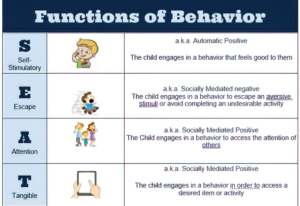Welcome back! If you were able to view our previous blog, you’ll recall we have been discussing the 4 functions of problem behavior and how to respond. This information can be helpful for parents, teachers, family members or babysitters! Please review our chart on the 4 functions of problem behavior:

Escape Behaviors
In our previous post, we discussed self- stimulatory behaviors! If you missed this, please check out part 2 of our series Functions of Behavior – Self-Stimulatory
The second function of behavior to consider is ESCAPE. Escape behaviors occur when an individual wants to get out of, or escape from, a situation. This often occurs when the child is being told to do something, such as go to bed or complete their homework. It may also be to escape overwhelming situations, such as a crowded room or a place with loud noises.
It is important to keep in mind that all of us engage in escape behaviors!
Consider, what do you do when:
– Someone invites you to an event you really don’t want to go to.
– You have had a rough week and don’t feel like going to work.
Have you ever been guilty of making up an excuse to get out of plans? All of us have, at some time, been guilty of trying to “get out of” or escape from something we do not want to do. The primary difference between us and our children with autism is that we are aware of socially appropriate ways to do this. Our children often do not have the communication skills to convey why they do not want to do what we have asked. This does not mean that we immediately give into what they want, but it is important to keep in mind and be understanding.
How to Intervene
The most helpful method of intervening is to intervene early and prompt a more appropriate response! This helps us avoid the larger behavior altogether. This involves identifying precursor behaviors and using antecedent strategies. We will address these in a future blog post, so stay tuned!
If your child’s frustration has escalated and they are engaging in inappropriate behaviors, then we will use a few basic strategies. There are 2 goals when your child is in this state:
1. De-escalate- we want to assist them in calming their bodies and their minds so that they can return to a state in which their brains are ready to listen and learn
2. Not reinforce- we also do not want them to learn that this behavior is how they get what they want. So we have to ensure we do not give them access to what they want (in this instance escape) following the inappropriate behavior
When a child is engaging in behavior for any reason, the best thing to do is to remain calm and keep them safe. This means that you may need to move dangerous items out of the way. It also may mean that you allow someone else to step in if you become too upset or frustrated.
When a child engages in behaviors in order to escape from something, we want to ensure that we gently teach them that this is NOT how they get what they want. We can do this in a few ways:
1. Follow Through: We remind them of what they are supposed to be doing by repeating the request every 10 seconds.
a. We may help them by pointing, gesturing or moving the item closer to them.
b. We should never grab them and force them to do something.
c. Accept anything that is close to the correct response! For example, my son is supposed to throw away his trash and begins to have a meltdown. I might hold the trash can under his hands. If he accidentally drops it into the trash can,
tell him “thank you for throwing that away!” and move on.
2. Wait Strategy- Sometimes our children just need time to breathe and calm down.
a. If this is your child, then step back and give them space.
b. Do not remind them of the task at hand or talk to them at all.
c. Just allow them to calm and get out of the “fight or flight” mode they are currently in.
d. Once they are calm, gently talk to them. Perhaps ask them to do something simple that they know how to do.
e. After they have calmed down, you should return to the thing that caused the meltdown- but perhaps change it by making it into a game or rewording it!
3. Switch it up!- another strategy that I do not often use but many families find helpful is to switch up the task.
a. Ask them to do something different that is simple and they are likely to do
b. Once they have completed 2-3 simple tasks, give praise and then immediately return to the original task that they were supposed to do.
The key to each of these strategies is that the child eventually has to do the original task that they were asked to do. If they engage in inappropriate behavior, we are not going to have them move on to fun activities without completing the activity that first caused the problem behavior.
This teaches them that, no matter how they behave, they will still have to do what you have asked them to do.


